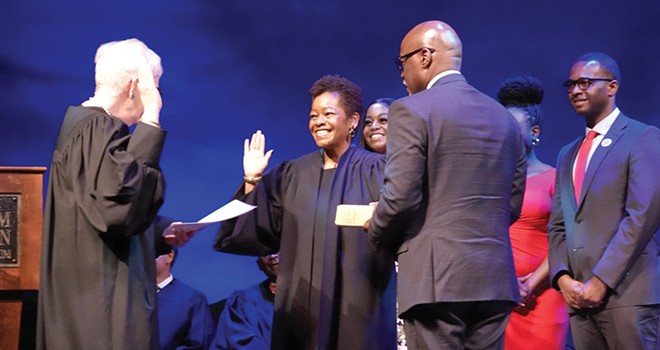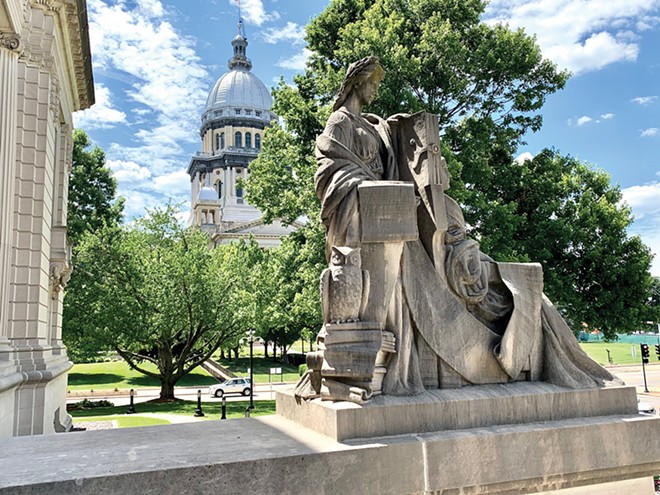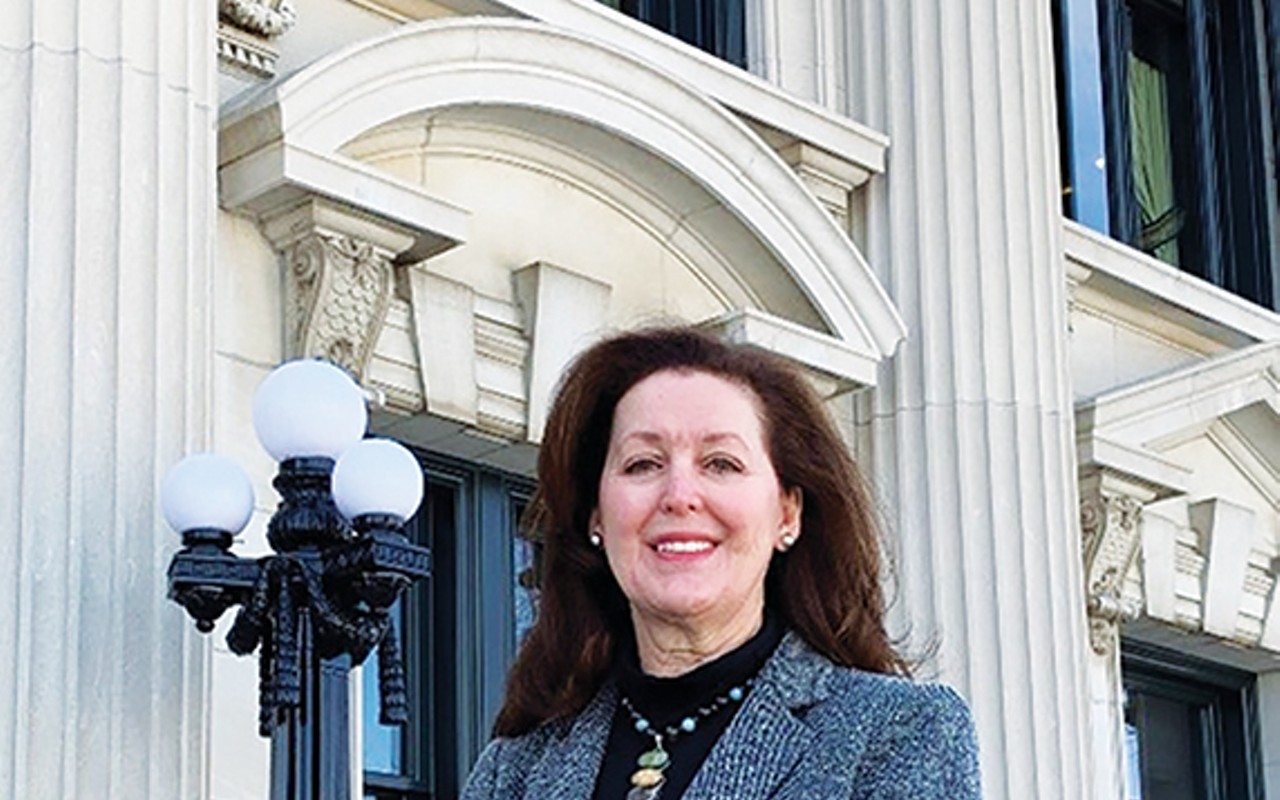
On July 7, Justice Rita Garman retired from the Illinois Supreme Court and Justice Lisa Holder White was sworn in to replace her. Garman, 78, was the longest serving judge in Illinois, having served 48 years, including 21 on the Illinois Supreme Court. Garman says she has "had an amazing career and lived the impossible dream." Justice Lisa Holder White has "an attitude of gratitude." She has been a judge for over two decades, serving as judge for the Appellate Court, Fourth District since 2012. White, 54, has had a distinguished career and is the first Black woman to serve on the state's highest court. Both women are trailblazers in the judicial system.
Garman resides in Danville, and White is a native of Decatur. Because Garman announced her retirement more than 60 days before the primary election, the Supreme Court had the responsibility to appoint her replacement, who will then run for election in 2024. Garman recommended that the justices appoint White. She knew White's work as a circuit judge and had recommended her in 2012 for the appellate court. Both Garman and White are Republicans.
Justice Lisa Holder White
Lisa Holder White was born and raised in Decatur and recently moved from Decatur to the Springfield area. She is active in the community. She is a member of the Decatur Bar Association, served on the board of the Decatur Public Schools Foundation, has an honorary doctorate degree from Millikin University and has received numerous awards from Decatur community organizations. White is a member of the Antioch Missionary Baptist Church where she serves as a deaconess and enjoys singing in the choir. She and James, her husband of 34 years, are the parents of two adult children, Brett and Myah.
White was appointed to the bench as associate judge in 2001, at the age of 33. She became the first Black judge in the Sixth Judicial Circuit, which includes Champaign, DeWitt, Douglas, Macon, Moultrie and Piatt counties. She later served as circuit court judge and appellate court judge. She also has experience as an assistant state's attorney, assistant public defender and working in private practice.

White's parents moved from Cairo to Decatur in the early 1960s. Her father was a factory worker; her mother had secretarial jobs and later owned a beauty shop. They moved to the Wildwood subdivision in the Macon school district when she was entering fourth grade. She and her two sisters were the only Black students in her school. There were 48 students in her 1986 Macon Community High School graduating class.
Although her parents hadn't gone to college, they encouraged her to be a lawyer. They thought this would be a good match since people always wanted to talk to her and she responded with convincing arguments about the topic at hand. White attended Richland Community College and earned a Bachelor of Arts degree from Lewis University in Romeoville. She earned her Juris Doctor degree from the University of Illinois Urbana-Champaign in 1993. At the age of 50, White's mother went to college and became a teacher and principal.
White's first legal position was assistant state's attorney for Macon County, where she gained experience with traffic and felony cases. She then worked as an assistant public defender litigating on behalf of those charged with criminal offenses and representing abused and neglected children. She also worked in private practice, handling criminal cases and family law. She believes working in central Illinois has been a benefit to her career as she had opportunities for a wide variety of experiences. She remembers the exact date she first met Justice Garman – March 5, 2001. They met at White's swearing in as associate judge when Garman was running for the Supreme Court.
As associate judge in the early 2000s, White was active in securing and implementing the Redeploy Illinois grant intended to reduce the incarceration rate for nonviolent juvenile offenders. Garman was instrumental in White's appointment by the Supreme Court to fill a circuit judge vacancy in 2008. She was then elected to the position in 2010. Garman also recommended White when there was a vacancy on the Fourth District Illinois Appellate Court. The Supreme Court appointed her to the position in 2012, and she was elected in 2014.
White is dedicated to judicial education. She served on and chaired the Illinois Supreme Court committee that provides continuing legal education for judges. She led a group responsible for planning seminars for new state court judges and frequently teaches at educational conferences that are part of mandatory continuing judicial education. She previously chaired the Illinois Judicial College Board of Trustees and presents seminars for Leadership Illinois, the Illinois State Bar Association and Illinois Institute of Continuing Legal Education. Judge White is also dedicated to giving back to the community and engaging with young people. She uses the courtroom to host mock trials with schoolchildren and provides students opportunities to learn more about career opportunities, the legal profession and what it is like to be a judge. She has also planned and hosted activities to provide Girl Scouts the opportunity to meet and learn from women who serve as judges, police officers, attorneys, court reporters and probation officers.

White says judges must understand the importance of being fair, and that it is inappropriate for a judge to make a decision based on partisanship. She says she is dedicated to the role of the court in rendering a decision in a fair and unbiased manner according to law.
White enjoyed collegiality at the appellate court and looks forward to the same on the Supreme Court. "It's important that people understand we don't make the law; we interpret law," said White. White says she intends to communicate with people about the importance of the court. People may not realize that appealing cases to the Supreme Court is not a matter of right. The Supreme Court determines what cases it will take in response to a petition to appeal. In contrast, the appellate court, with few exceptions, will hear cases decided by the circuit courts. She also emphasizes that decisions are based on the standards of review; the court does not retry cases.
White says she considers herself blessed, and feels the weight of serving on the Supreme Court and following Justice Garman, whom she deeply admires. As the first Black woman on the Illinois Supreme Court, White says she may be the first to achieve this, but not the first who was qualified. She believes diversity is important as it provides perspective. "We need many perspectives to get things right," said White. It is important to her to be opening a door.
Justice Rita Garman
Rita Garman knew from the age of 15 she wanted to be a lawyer. Others weren't encouraging. A professor advised her not to pursue a six-year joint degree in commerce and law at the University of Illinois and instead get an undergraduate degree in a specific field. She met her husband at the U of I and, after earning her degree in economics in 1965, they both went to law school at the University of Iowa, where she graduated with distinction in 1968. It was not a welcoming environment. Some suggested she was taking a spot away from a man. Others recommended she get a job and put her husband through law school. Out of 160 students, there were only eight women and one African American male. She excelled and benefited from the fact that students were graded by number rather than name. After earning her J.D. degree, it wasn't easy to find a job. She was offered the same position as a male classmate at a significantly lower salary. A law firm told her they didn't know what they would do with her since clients don't want to talk to women. This was the 1960s.
Garman's career includes decades of service as associate judge, circuit judge and appellate court judge, in addition to private practice. She got her first job by luck, working in the legal aid office in Danville. That led to working in the state's attorney's office handling family cases and serving four years as assistant state's attorney in Vermilion County and later working in her husband's law firm. When an associate judge retired, she applied to be appointed. On Christmas Eve 1973, with her two-year-old daughter in the car, she heard WGN report that a woman had been appointed a judge in downstate Illinois. That's how she learned she was selected. At the time she was one of only eight female judges in Illinois. After serving as associate judge for 12 years, she was elected circuit court judge in 1986 in the Fifth Judicial Circuit. In July 1995 she was assigned to the Appellate Court, Fourth District, and was elected to the position in November 1996. When Ben Miller retired from the Illinois Supreme Court, he recommended Garman to fill his term. She was appointed to the Supreme Court on Feb. 1, 2001, and elected on Nov. 5, 2002.
Garman has seen a lot of changes during her long career. She credits Title IX of the Civil Rights Act of 1964, which outlaws sex-based discrimination in education, as having a big impact. She also says that in the 1970s women got into professions that were not very accessible previously. She says the old guard had daughters who wanted to be lawyers, and that made a difference. "The door didn't swing open, but the crack kept getting bigger," said Garman.
Garman is most proud of the opportunity to impact the law in a positive way. Garman says she has worked with a collegial group of justices during her more than two decades on the Supreme Court. They may agree or disagree depending on the case and may agree on one case and not another. It is never nasty and never personal. She cites the critical importance of judicial independence. Access to justice in step with the times...this was a particular challenge during COVID. Remote proceedings would have been unheard of in the past, but now they have proven this can be done.
Another responsibility of Supreme Court justices is to appoint justices when there are vacancies and make appointments to committees. Justice Garman has had a significant impact in increasing the number of women and the diversity of people appointed to these positions.
Judges must run for retention every 10 years. Garman was up for retention in 2022, but decided the timing was best for her to step down. She wanted to go out on top on her own terms. She has seen people stay too long and not be able to enjoy retirement. Garman has five grandchildren – ages 21 to 3. She had the pleasure of living near her oldest grandchildren in Danville, and now she wants to be more actively involved in the lives of her younger grandchildren, who live in Des Moines.
Karen Ackerman Witter started freelance writing after a 35-year career working in the executive branch of Illinois state government. She is a frequent contributor to Illinois Times..




